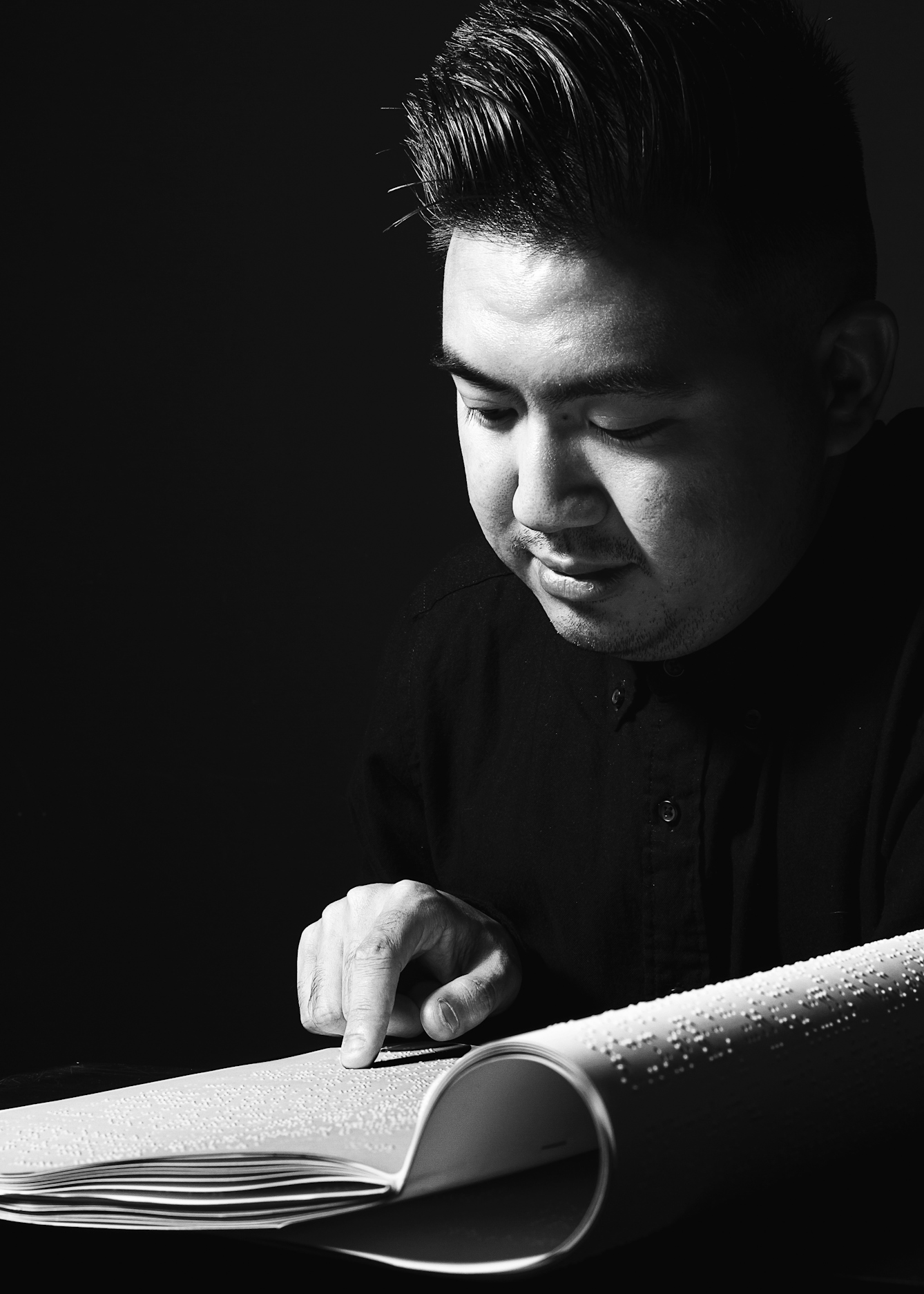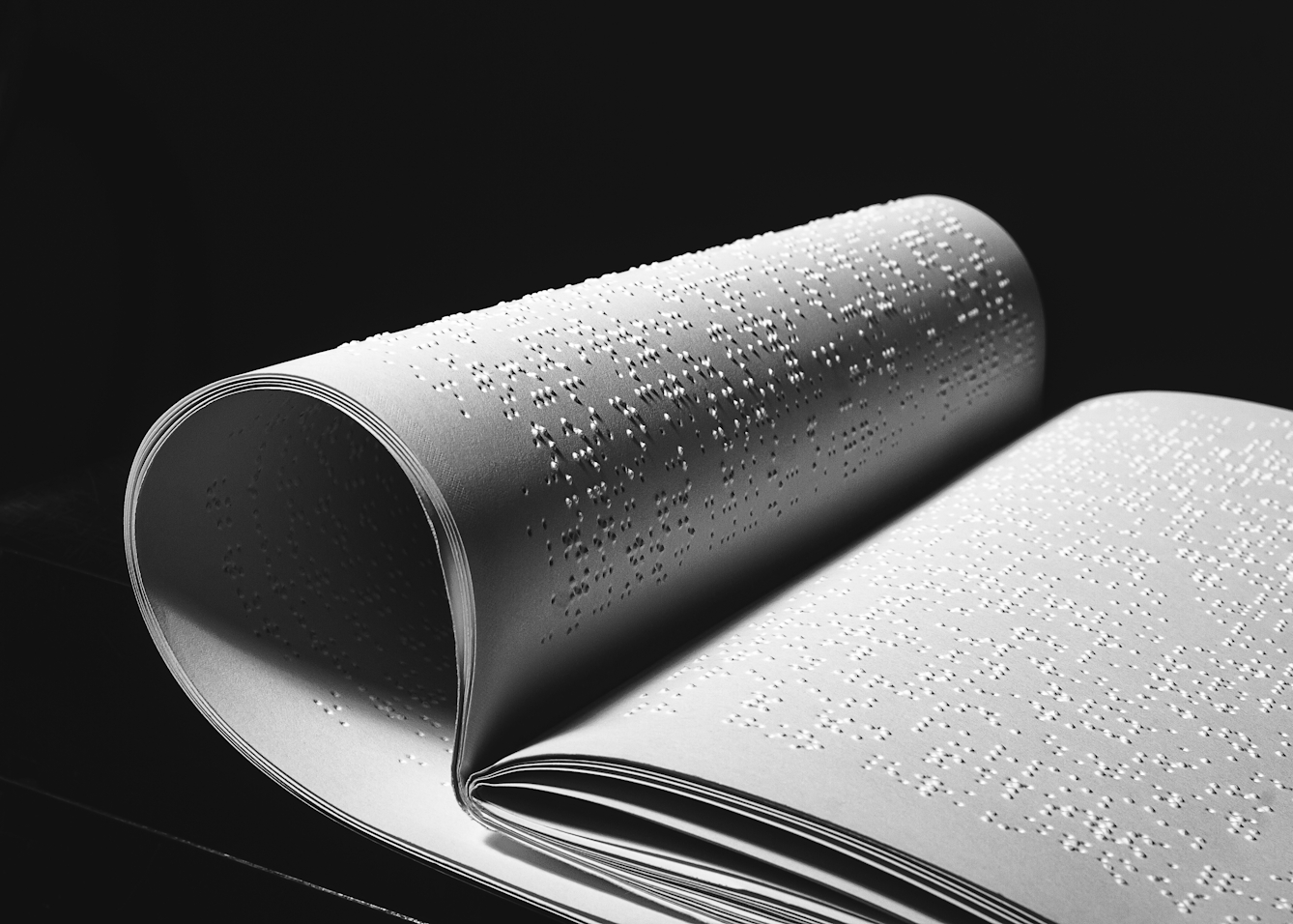When Alex Lee lost much of his sight in 2013, Braille was falling out of fashion. But he embarked on the complex task of learning it when the shortcomings of screen readers became obvious. Here he explores Braille’s faltering history and its modern resurgence.
Bringing Braille back to the modern world
Words by Alex Leephotography by Ian Treherneaverage reading time 7 minutes
- Serial

No one introduced me to the tactile language of Braille when I started losing my sight in early adulthood. Assistive technology for blind people was rapidly evolving, and Braille was on the way out. It was becoming obsolescent, even unnecessary. “No one was learning it any more,” a social worker once told me.
For years I remained blissfully unaware of how Braille worked or why it was even useful in a world where synthetic voices could read to me. But throughout university and then entering the workplace, when presentations became a regular occurrence, I found myself trying to memorise lines as if I was rehearsing for a primary-school play. As I tried to regurgitate the words being spoken in my ear by a synthetic robot voice, I knew that there must be a better way.
Learning Braille is a lot like learning a new language, but it requires a depth of sensitivity in the tips of the fingers and a surprising amount of concentration. I’ve only recently started learning how to read the tactile medium, but I’ve already realised that it’s frustratingly difficult. While I’m still a way off reading presentation notes or an entire book in Braille, feeling for elevator numbers has become one saving grace.
In 1771, French linguist Valentin Haüy was stopping for lunch in a Parisian café when he witnessed blind people being made to wear dunce hats and glasses, and play instruments discordantly for onlookers’ glee. Outraged by the mockery, Haüy decided to develop a tactile reading system that would allow blind people to read. His system impressed typographic shapes onto wet paper, raising them up and allowing them to be physically felt.
Haüy went on to set up the world’s first school for blind children in 1784, where he taught them how to read using his clunky, embossed tactile reading system. It only allowed a limited number of words on a single page and couldn’t be replicated by the students themselves. Tactile systems didn’t develop any further until 1815, when French army officer Charles Barbier invented a system soldiers could use to read and write in the dark.
Barbier’s night-writing system consisted of a two-column grid with six rows in each column. A writer could score marks in each row to form a shape that corresponded to a letter. It was highly complex, and when Barbier took his invention to his superiors, it was deemed too complicated for soldiers to use in the field.
So, in 1821, Barbier took his system to Haüy’s Royal Institute for Blind Youths in Paris instead. There, a 12-year-old boy called Louis Braille, who had lost his eyesight aged three, was despairing at the limited range of Haüy embossed books in the library, having read them all multiple times.
Braille decided to take everything good about Barbier’s system and make it better. By 1824, Braille had simplified it to just six simple dots arranged in the same two-column format. People could read a letter with just one finger.

“Learning Braille is a lot like learning a new language, but it requires a depth of sensitivity in the tips of the fingers and a surprising amount of concentration.”
Resistance and regeneration
Despite much advocacy, Braille’s system wasn’t widely embraced until two years after his death in 1852. A headmaster at the Paris school for blind children was even dismissed from his role because he translated a textbook into Braille. Most resistance to Braille, ironically, involved sighted people. Braille’s own school banned his system because it feared that sighted teachers would be out of a job if blind people could educate other blind people.
In the UK, Braille didn’t look enough like actual print, making it impossible for sighted people to read it. But blind people themselves, agreeing that Braille was the best system for their own needs, eventually helped it gain traction.
In the early years of Braille, students would write with a slate and stylus, punching holes into the back of a piece of paper. It was laborious, and didn’t get much better until a man named Frank Haven Hall – a superintendent of a school for blind children in Illinois – took matters into his own hands and developed the world’s first Braille typewriter with local metalworker Gustav Siebel.
Braille’s own school banned his system because it feared that sighted teachers would be out of a job if blind people could educate other blind people.
The Hall typewriter was fashioned like a piano with just six keys, and each one was made by hand. Hall never patented the typewriter because he didn’t want to profit from visually impaired people, and similar Braille typewriters flourished over the next 50 years.
Every Braille typewriter developed in the first half of the 20th century was noisy and prone to getting jammed. The original Perkins Braille writer – now the most used Braille writer in the world – was discontinued in 1932 because of the awkward design, after Gabriel Farrell became the director of the Perkins School for the Blind in Massachusetts.
When a carpenter named David Abraham from Liverpool started working at the school as a woodwork teacher, Farrell set him the challenge of designing a Braille writer without all of the flaws present in the earlier model. By the late 1930s, Abraham had built a quiet, sturdy typewriter with easy-to-press keys and a paper roller that sat inside the machine rather than outside. By 1951, the Perkins Braille writer was being manufactured at scale, and flying off the shelves.

“I’ve only recently started learning how to read the tactile medium, but I’ve already realised that it’s frustratingly difficult.”
Refreshable Braille on-screen
When computers entered the scene, the Massachusetts Institute of Technology (MIT) developed a Braille translation system that converted information on IBM terminals into Braille and outputted it onto printed pages. Braille printers (or Braille embossers, as they’re formally called) were followed by refreshable Braille displays.
Refreshable displays work similarly to screen readers, but instead of translating text into speech, they use a complex electric charge effect, which lifts pins up and down in physical cells of raised dots underneath the reader’s fingertips.
“It’s very intricate technology that costs a lot of money – we’re talking probably about £40 a cell, so your average 40-cell Braille display – just the cells alone – would cost you about £1,600,” explains Matthew Horspool, a Braille expert at the UK Association for Accessible Formats and a trustee at the Braillist Foundation. “And then there’s the cost of the motherboard and the plastic housing and the labour.”
Newer devices hover around the £1,300 mark. Horspool says that these new devices are a little bit slower and noisier because they use rotating cogs to lift the pins, but they’re making Braille more affordable for visually impaired people.
Freed from print, Braille has become much less cumbersome (there are 56 volumes of the ‘Harry Potter’ books in Braille, for example, and each one is nearly a foot tall): books can be stored on phones or connected up to Braille displays. Despite Braille being more accessible than ever, fewer and fewer visually impaired people are learning it. In the US, the National Federation of the Blind estimates that only 10 per cent of visually impaired people can read it.
But in the last couple of years, Horspool has seen a change. Like me, he’s noticed more people wanting to learn Braille, despite having access to text-to-speech software. “You have a generation of people who don’t learn Braille. As adults, they start to talk and start saying they really wish they learned this while they were at school because it would have been so useful,” he says.
“We’re kind of at that point. I think we’ve got past the peak of the decline and now I think we will start to see an increase.” It seems Braille may have been rescued from the brink of death by people like me belatedly realising its worth.
About the contributors
Alex Lee
Alex is a tech and culture journalist. He is currently tinkering with gadgets and writing about them for the Independent. You may have previously seen his work in the Guardian, Wired and Logic magazine. When he’s not complaining about his struggles with accessibility, you’ll likely find him in a cinema somewhere, attempting to watch the latest science-fiction film.
Ian Treherne
Ian Treherne was born deaf. His degenerative eye condition, which by default naturally cropped the world around him, gave him a unique eye for capturing moments in time. Using photography as a tool, a form of compensation for his lack of sight, Ian is able to utilise the lens of the camera, rather than his own, to sensitively capture the beauty and distortion of the world around him, which he is unable to see. Ian Treherne is an ambassador for the charity Sense, has worked on large projects about the Paralympics with Channel 4 and has been mentored by photographer Rankin.

